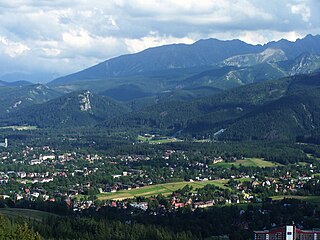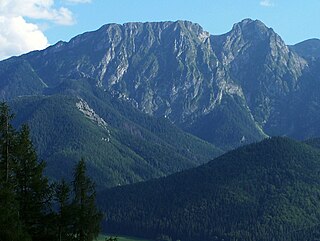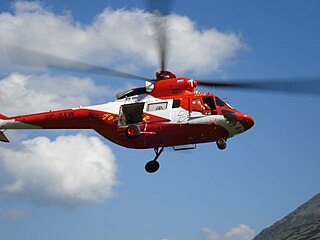
Zakopane is a town in the south of Poland, in the southern part of the Podhale region at the foot of the Tatra Mountains. From 1975 to 1998, it was part of Nowy Sącz Voivodeship; since 1999, it has been part of Lesser Poland Voivodeship. As of 2017 its population was 27,266. Zakopane is a centre of Goral culture and is often referred to as "the winter capital of Poland". It is a popular destination for mountaineering, skiing, and tourism.

The Tatra Mountains, Tatras, are a series of mountains within the Western Carpathians that form a natural border between Slovakia and Poland. They are the highest mountains in the Carpathians. The Tatras are distinct from the Low Tatras, a separate Slovak mountain range further south.

Rysy is a mountain in the crest of the High Tatras, eastern part of the Tatra Mountains, lying on the border between Poland and Slovakia. Rysy has three summits: the middle at 2,501 m (8,205 ft); the north-western at 2,500 m (8,202 ft); and the south-eastern at 2,473 m (8,114 ft). The north-western summit is the highest point of Poland and belongs to the Crown of Polish Mountains; the other two summits are on the Slovak side of the border.

Giewont is a mountain massif in the Tatra Mountains of Poland. Its highest peak, Great Giewont, is 1,894 metres (6,214 ft)1,894 metres (6,217 ft) above sea level and the highest peak of the Western Tatras located entirely within Poland's borders. The mountain is regarded as the symbol of Zakopane, the Polish Tatras and Podhale, which throughout history has been the subject of many legends, poems and works of art.

Morskie Oko, or Eye of the Sea in English, is the largest and fourth-deepest lake in the Tatra Mountains, in southern Poland. It is located deep within the Tatra National Park in the Rybi Potok Valley, of the High Tatras mountain range at the base of the Mięguszowiecki Summits, in Lesser Poland Voivodeship. In 2014, The Wall Street Journal recognized the lake as one of the five most beautiful lakes in the world.

Kościelisko is a village in Tatra County, Lesser Poland Voivodeship, in southern Poland, close to the border with Slovakia. It is the seat of the gmina called Gmina Kościelisko. It lies approximately 5 kilometres (3 mi) west of Zakopane and 86 km (53 mi) south of the regional capital Kraków.

Mariusz Zaruski was a brigadier-general in the Polish Army, a pioneer of Polish sports yachting, an outstanding climber of the winter and caves of Tatra Mountains. He was a photographer, painter, poet and writer, a seamen and traveler, a conspirator, legionnaire and lancer in Polish cavalry.

Mieczysław Szczuka was a Polish avant-garde artist and mountaineer.

Tatra Volunteer Search and Rescue is a non-profit mountain rescue organization in Poland, rescuing stranded mountain climbers, tourists, and others in need of rescue in the Polish Tatra mountains. It is one of the oldest mountain rescue associations in the world.
Jerzy Roman Porębski is a Polish documentary film producer, scriptwriter, screenwriter, writer and co-writer, director and agent for mountaineering books. Mountain culture consultant. His films mainly concern mountaineering and mountain rescue themes. He is interested in explorers, challenges, mountaineering, mountain culture and history.

Tadeusz Popek was a Polish partisan and underground activist during World War II. During the German occupation of Podhale, Popek became the co-founder of the Polish resistance organization called the Tatra Confederation, a.k.a. Confederation of the Tatra Mountains, operating in the Nowy Targ area. He was in charge of clandestine publications including Der Freie Deutsche meant for the Wehrmacht. Popek died in Zakopane, executed by a firing squad in the courtyard of the infamous Palace Hotel.
Ludwik Chałubiński was a Polish alpinist and chemical engineer.

Wielki Staw Polski - is a tarn located in the High Tatras, at an elevation of 1,665 metres in the Valley of the Five Polish Lakes, by the slope of the Miedziane. It's the second-largest lake by area in the Tatra Mountains, just after Morskie Oko. The lake is located in Poland in the Lesser Poland Voivodeship.

Sabała or Sablik was a Goral amateur musician, storyteller and folk singer active in or around the Tatra Mountains. A friend to many renowned Polish artists of the late 19th century, he is featured in numerous Polish works of art of the epoch.

Sub-Tatra Trench (514.14) - a mesoregion located below the Tatra Mountains, part of the Orava-Podhale Depression. The trench divides the Choč and Tatra Mountains from the Spisko-Gubałowski Plateau.
Antoni Kocyan was a Polish-Hungarian naturalist, specimen collector, and forester. He was a collector of birds and small mammals particularly from the Tatra mountains. A Silurian fossil coral Avicenia kocyani is named in his honour.

Siklawica Falls is a waterfall located in the Western Tatras, south of Zakopane, Poland, dropping a total of 24 m (79 ft) making it the second highest waterfall in the Polish Tatra Mountains.

Mickiewicz Falls is a waterfall in the Tatra National Park, Lesser Poland, consisting of three main cascades dropping a total of 10 metres (33 ft).
Men of the Blue Cross is a Polish war narrative-documentary film from 1955 directed by Andrzej Munk, based on Adam Liberak's short story Journey for Life. The film reconstructs the authentic action of the Tatra Volunteer Search and Rescue, which in February 1945 evacuated a partisan mountain hospital through the German-Soviet front line during World War II. In the Men of the Blue Cross, narrated by Gustaw Holoubek, some of the participants of that action appeared, including Stanisław Gąsienica Byrcyn and Stanisław Marusarz.

The Tatra lakes comprise approximately 200 bodies of water, excluding smaller and seasonal lakes, located within the Tatra Mountains. Of these, around 40 lakes are situated in the Polish Tatras, while the remainder are found on the Slovak side of the range. They are known for their clear waters and scenic surroundings, making them popular destinations for outdoor activities such as hiking and photography.


















